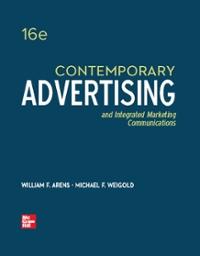

no special format
QUESTION 2. Part A. Imagine that you own and operate a local restaurant. The service or workspace is xed and there is no conceivable way to increase the size of the workspace in the current time period. However, you face a dilemma: Prior to last March 2020, business was strong. Regular customers and visitors to the local area came for the healthy food created with fresh vegetables, grass-fed beef and other locally sourced ingredients. Then, boom, COVlD-19. Restrictions (1) initially limited service to take-out and (2) now slowly customers have been allowed to return inside but with strict limitations. Business is expected to pick up due to strong desires of people to "eat out\" again with family and/or friends. So, the restaurant is considering adding extra hours once the COVID-19 restrictions ease, as more people are vaccinated. Instead of opening at 7AM, now the first shift will begin at 6AM. Instead of closing at 9PM, the last shift will leave at 11PM. The added expense of disinfecting workspaces and tables/chairs continues. A 1 Is this the long run or the short run? Explain your response. As restrictions are slowly lifted, the owners decide to go ahead and open with longer hours. So now there are more kitchen staff, wait staff and people working in the same original sgaces (following CDC guidelines). A 2 What can this restaurant expect in terms of additional output or production after adding workers in the short run? Explain. A 3 What can this enterprise or business expect in terms of additional (extra) COSTS from producing another unit of output? Explain. (Think about your answer to question A1.) A4 Draw the graph(s) to show the relationship between the additional product from hiring an extra worker (variable resource) and the additional costs from producing another unit of output. (see your answers to A2 and A3) A5 If this is the short run, what needs to change for this restaurant to be able to make more adjustments or changes to how economic resources are used? Located near Brattleboro, Vermont QUESTION 3. Identify each of the following (A-D) using one of the 4 market structures. Each market structure is only used once. Part A. There are many small towns across the country that have a single gas station and a single grocery. A 1. Market Structure: A 2 List two characteristics of this market structure other than those related to price/output. A 3 Describe how this type of rm sets price and output. A 4 Draw the appropriate graph to illustrate a loss for this type of rm. Be sure to label! Shade the area of the loss. Part B. Farms in southern California grow strawberries, alongside many competitors. B 1. Market Structure: B 2 List two characteristics of this market structure other than those related to price/ output. B 3 Describe how this type of firm sets price and output. B 4 Draw the appropriate graph to illustrate a prot for this type of rm. Be sure to label! Shade the area of the prot. Part C. Small local diners in a small city (population greater than 25,000 but less than 40,000). C 1 Market Structure: _ C 2 List two characteristics of this market structure other than related to price/output. C 3 Describe how this type of rm sets price and output. C 4 Draw the appropriate graph to illustrate a prot for this type of rm. Be sure to label! Shade the area of the prot. Part D. Verizon, AT&T, Sprint, T-Mobile, Spectrum D 1. Market Structure: D 2 List two characteristics of this market structure other than related to price/output. D 3 Describe how this industry sets price and output. D 4 Could regulation help this market move toward the efficiencies of perfect competition










